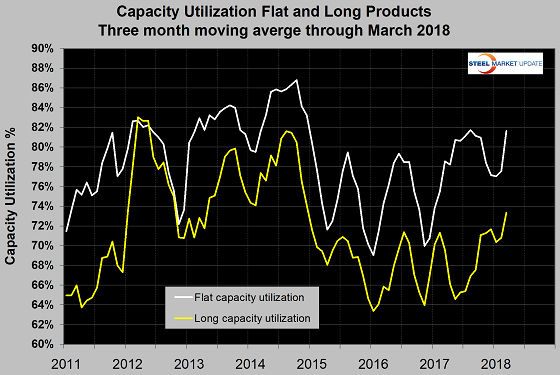Economy

Flat Rolled and Long Products Capacity Utilization
Written by Peter Wright
May 13, 2018
For steel producers, there’s a strong correlation between capacity utilization and profits. Steel Market Update tracks capacity utilization for both flat and long products and both have been on the upswing since early 2018, at least in part due to the effects of the Trump administration’s plans to impose tariffs on steel imports.
From January through March, domestic flat roll capacity utilization jumped from about 77 percent to 81.6 percent, while long product capacity increased from about 70 percent to 73.3 percent, as three-month moving averages. The uptrend appeared to continue in April and May. Although it is difficult to gauge actual mill production capacity, this chart represents SMU’s best estimate. While the industry average for raw steel production averaged about 76 percent in the first week of May, flat roll producers have topped the 80 percent threshold desired for healthy profitability.


Peter Wright
Read more from Peter WrightLatest in Economy

US sets Section 232 tariffs on trucks and buses
Medium- and heavy-duty trucks (MHDV) and buses imported to the US will start being charged Section 232 tariffs beginning Nov. 1.

AMU: Consumer auto delinquencies: Warning sign for consumer health?
The Consumer Federation of America estimates rising total auto debt at a staggering $1.66 trillion, along with increasing repossessions and a sharp increase in delinquencies.

Beige Book: Regional market growth remains mostly flat
Economic growth in some US regions in September was offset by challenges in others, causing the market to appear largely unchanged overall, according to the Federal Reserve’s latest Beige Book report.

ISM September survey captures deepening manufacturing gloom
The Institute for Supply Management’s (ISM) latest monthly report on manufacturing reflects a bleak view of American industry in September.

Key industries concerned over government shutdown’s impact on steel, manufacturing
Trade groups cautioned that a prolonged shutdown could strain US industry.
